Florida is home to lots of things, especially snakes. In fact, Florida is home to some of the most diverse snake populations across the entire United States! The warm climate, constant sun, and aquatic proximity make Florida the perfect home for these scaly reptiles. Today, we are going to take a look at some of these snakes, particularly the nonvenomous ones.
12 of the most common nonvenomous snakes in Florida
Overall, there are about 47 nonvenomous snakes that live in Florida. Still, this number isn’t all that helpful because most times, people only see a few of the most common species of snake. Here is a detailed description of some of the most common nonvenomous snakes you could encounter in Florida. Our complete list of nonvenomous snakes is under it!
Black pine snake
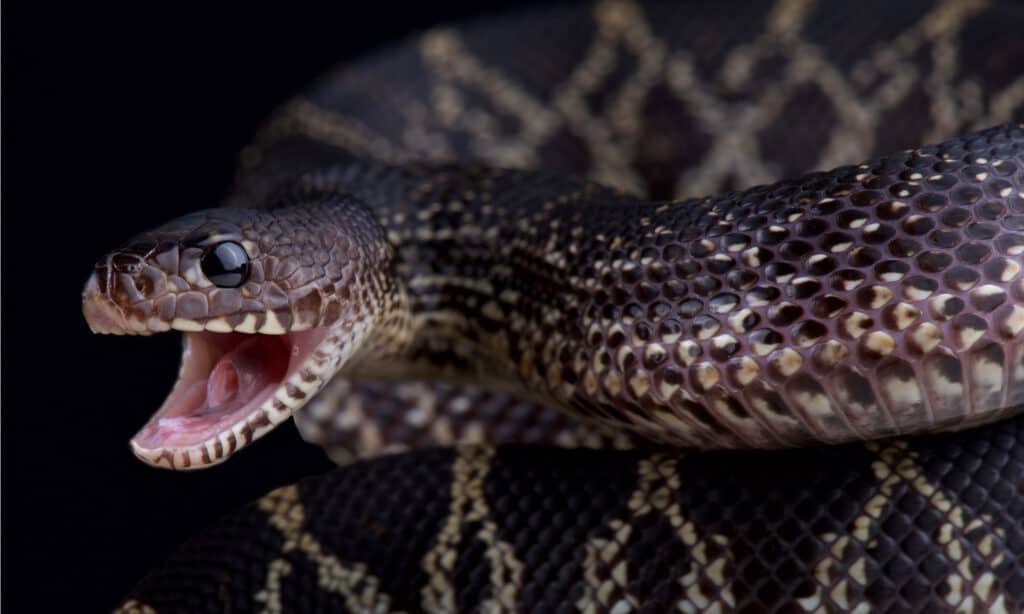
Black pine snakes live across most of Florida, except for the Keys.
©reptiles4all/Shutterstock.com
The black pine snake is a large, thick snake that has a reddish-brown blotch pattern on a cream or tan base color. Some pine snakes don’t have a distinct pattern and are just light-colored, while others may even look totally black.
These snakes can be found throughout most of the state, save for the Keys, the Everglades, and the southwestern region. As their name suggests, they are most commonly found in pine and turkey-oak stands. Pine snakes burrow in dry, sandy soil and are occasionally found in suburban habitats.
Black racer
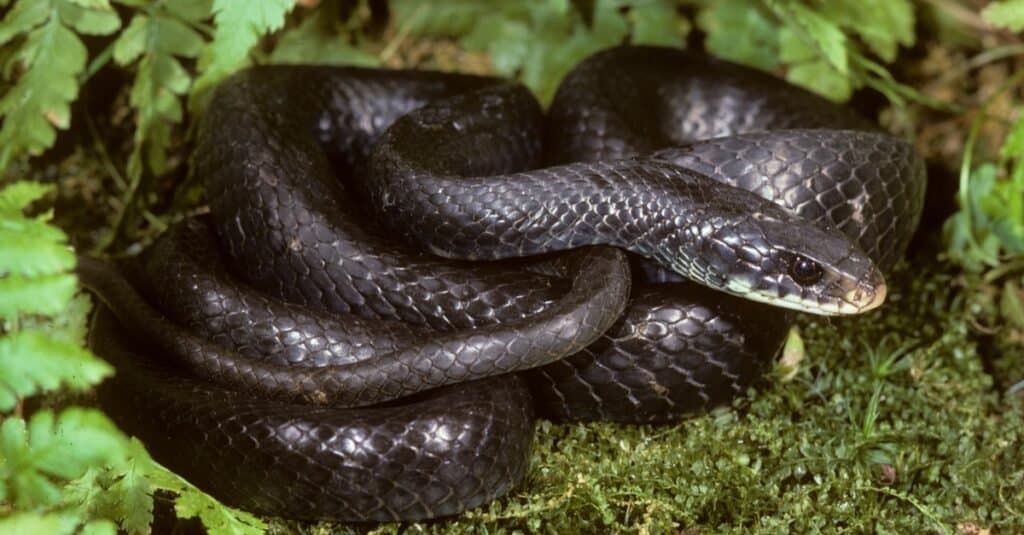
The black racer is an agile and very fast animal that can slither at 4 miles per hour when it is threatened, hence the name “racer”.
©Breck P. Kent/Shutterstock.com
The black racer is a long and slender snake with a black body and cream or white chin. Young snakes are brownish and often have reddish blotches that closely resemble that of a juvenile corn snake. Racers get their name from the speed at which they are known to move if threatened.
These snakes can be found in every portion of the state, including the Florida Keys.
Corn snake
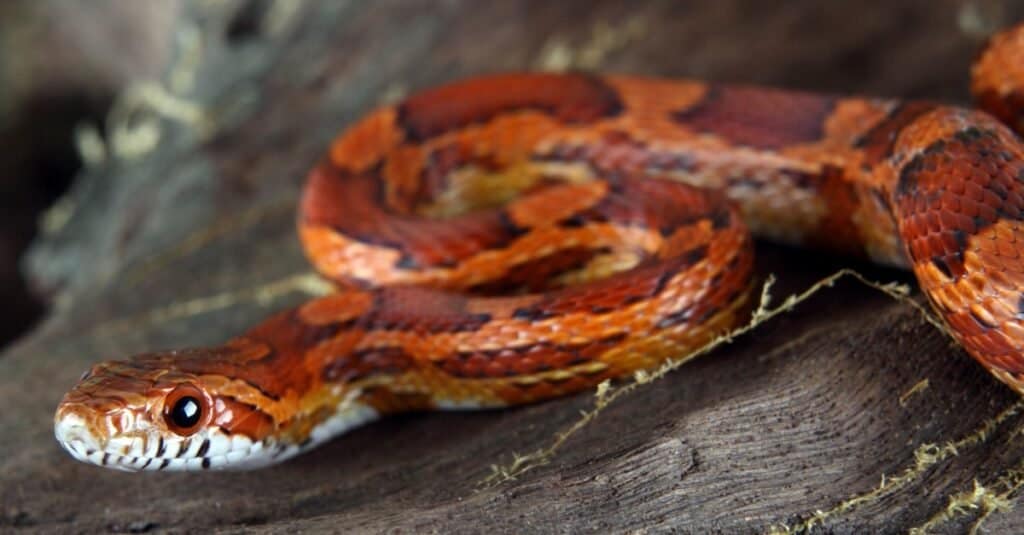
The corn snake is one of the most commonly kept pet snakes.
©Enrique Ramos/Shutterstock.com
Corn snakes are some of the prettiest snakes around. These snakes are medium-sized snakes that can grow to four feet long. They vary in color, but most individuals in Florida have a gray or white body with a bright red or orange pattern across their backs. Their bellies are checkerboard in black in white, giving them their name.
Corn snakes are found across all of Florida, including the Keys. They are also kept as pets and sold in stores.
Eastern coachwhip
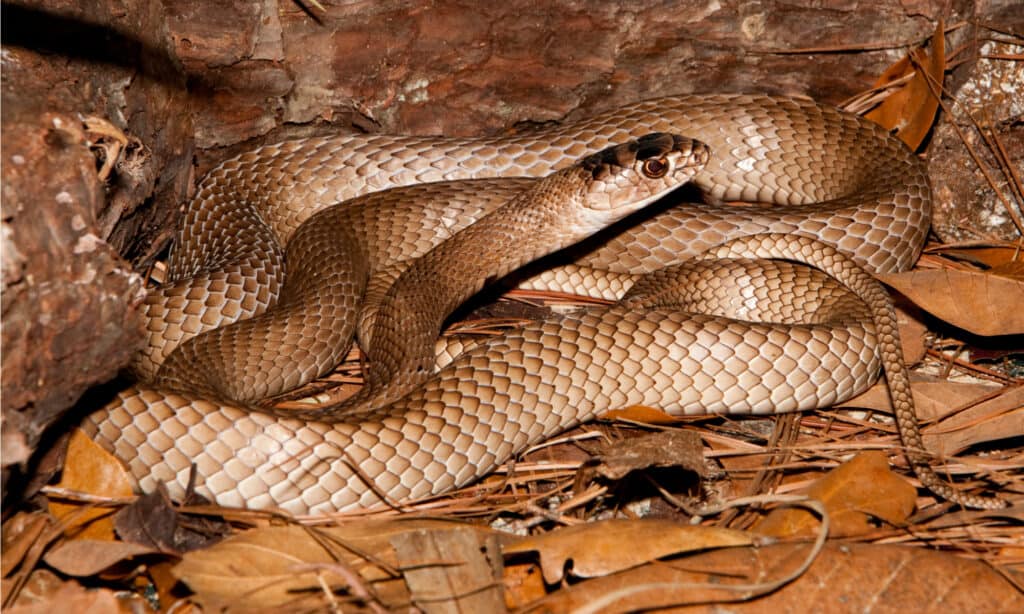
Adult eastern coachwhips have black heads and necks.
©Jay Ondreicka/Shutterstock.com
The eastern coachwhip is a long, slender snake that can grow to 4-5 feet long. As adults, the eastern coachwhips have light tan bodies and extremely dark brown or black necks and heads, giving them a curious two-toned look. Additionally, they have prominent yellow irises.
The eastern coachwhip can be found throughout mainland Florida.
Banded water snake
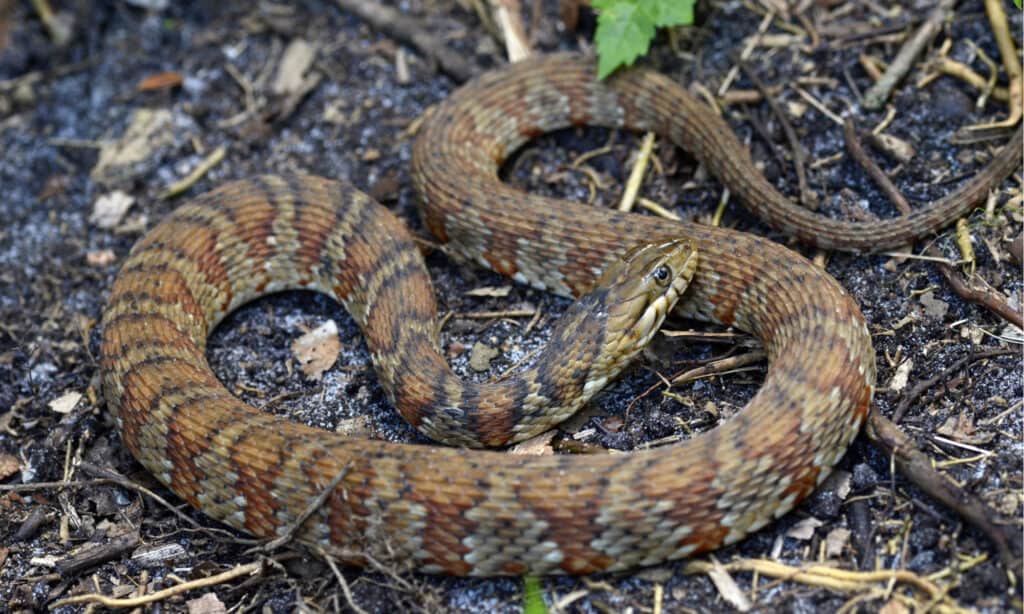
The banded water snake has light tan and brown stripes.
©Patrick K. Campbell/Shutterstock.com
The banded water snake is a large snake with a brown body and dark brown cross bands running from head to tail. The thick bands are usually darker, while the thin bands are lighter and can occasionally be shades of red or yellow.
Banded water snakes can be found throughout mainland Florida.
Brown water snake
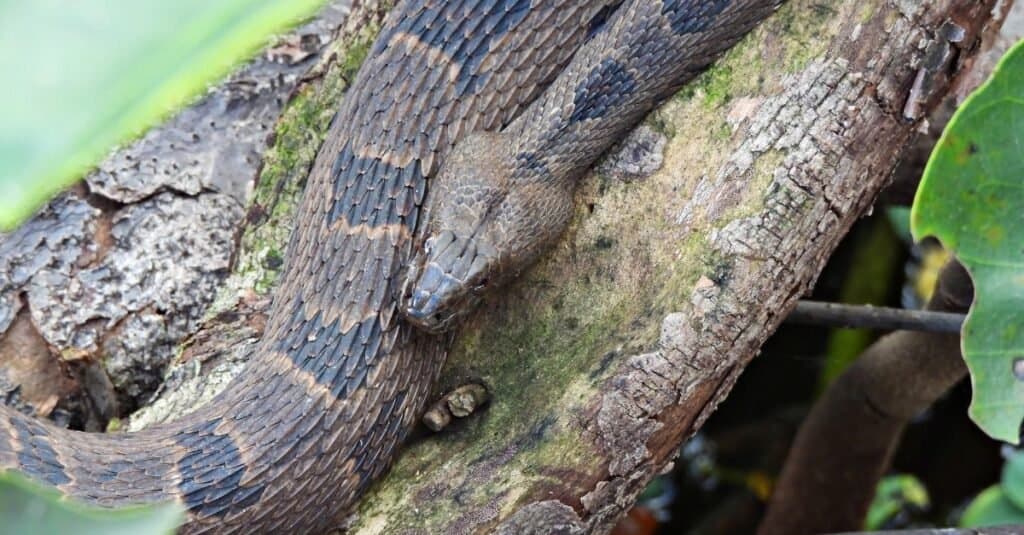
Brown water snakes have a triangular head, with the eyes being set toward the top.
©iStock.com/passion4nature
The brown water snake is similar to the banded water snake in size and length. Brown water snakes have brown bodies with dark brown or black squarish markings across their backs. They can slightly resemble the water moccasin, although brown water snakes aren’t venomous or dangerous.
These snakes can be found throughout mainland Florida. They generally prefer rivers, saw grass, swamps, and other wetlands.
Mississippi green water snake
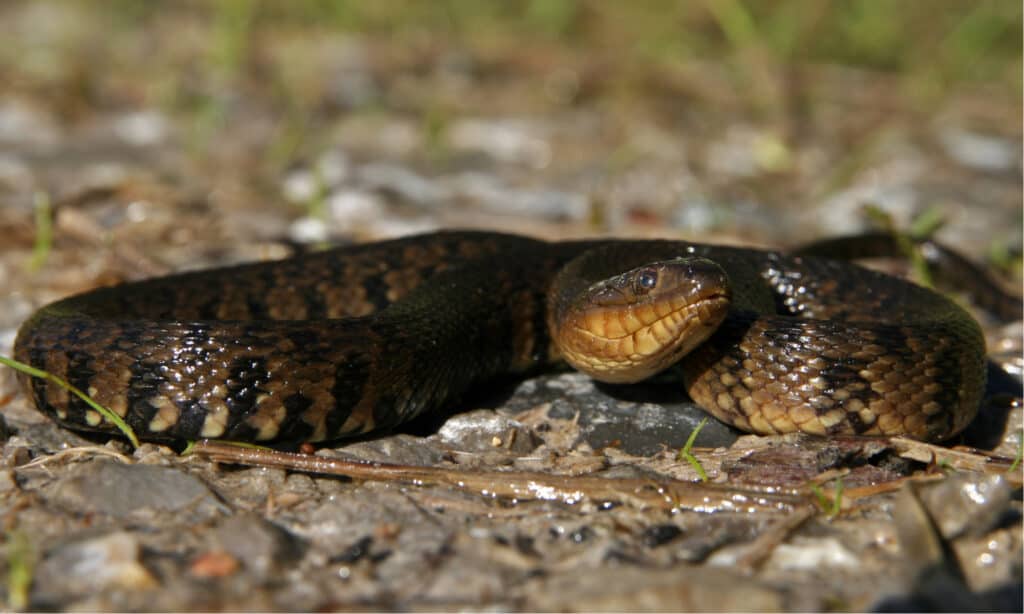
The Mississippi green water snake is known for its slightly green coloration.
©Ryan M. Bolton/Shutterstock.com
The green water snake is also similar in size to the other water snakes on the list. This snake is stout and has a dark green background color and narrow markings down the back and sides. Although its color is often recognized as “green,” it can often be mistaken as brown or olive.
This snake is found exclusively around coastal Escambia County in the far western Panhandle.
Rough green snake
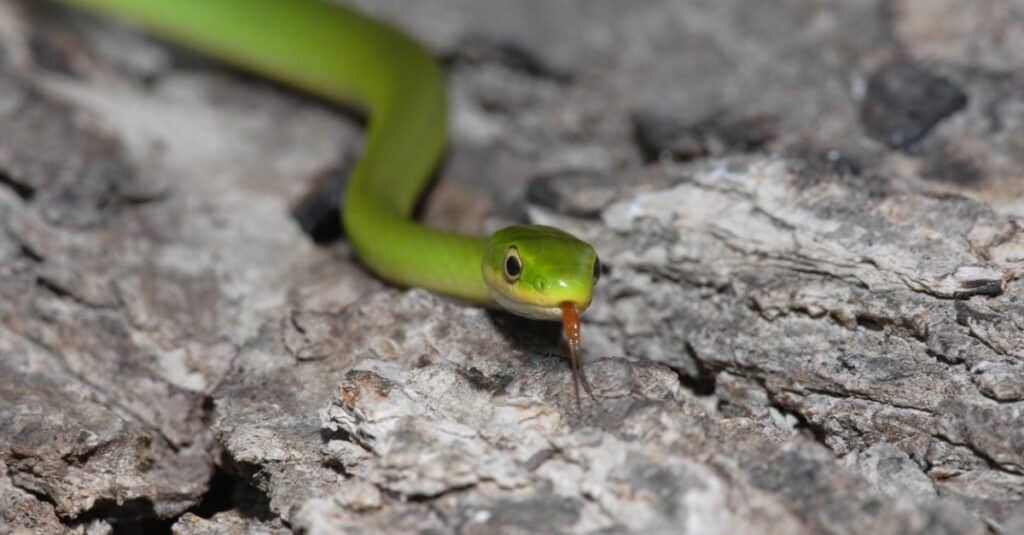
Rough green snakes are extremely common around trees and shrubs.
©iStock.com/Shoemcfly
The rough green snake is a small and slender snake that is bright green in color, with a pale cream or yellow belly. This little snake is only a few inches long and can be extremely vivid.
The rough green snake is found throughout the entire state, including the Florida Keys. It generally prefers forests and meadows but is mostly arboreal, spending its time in trees and shrubs.
Garter snake
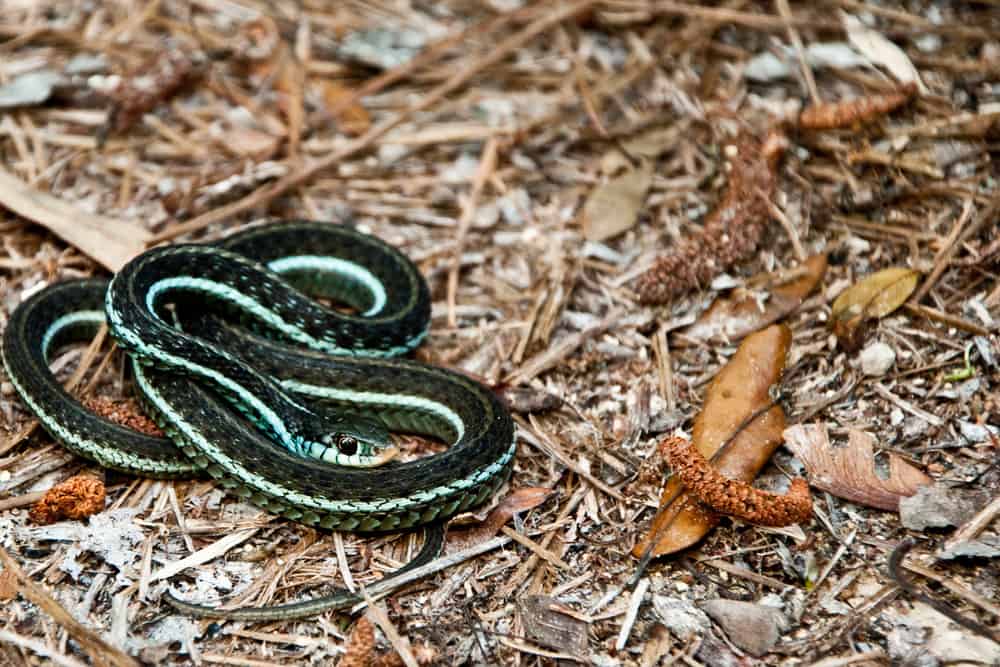
Some garter snakes in Florida have blue stripes instead of the standard yellow.
©Jay Ondreicka/Shutterstock.com
The garter snake is one of the most common snakes in the eastern United States. Garter snakes are medium-sized snakes that can grow to 2 or 3 feet in length. They have three thin stripes running vertically down their backs. The stripes can vary in color but are usually yellow, green, brown, blue, or white.
Garter snakes can be found throughout Florida, including the Keys.
Kingsnakes
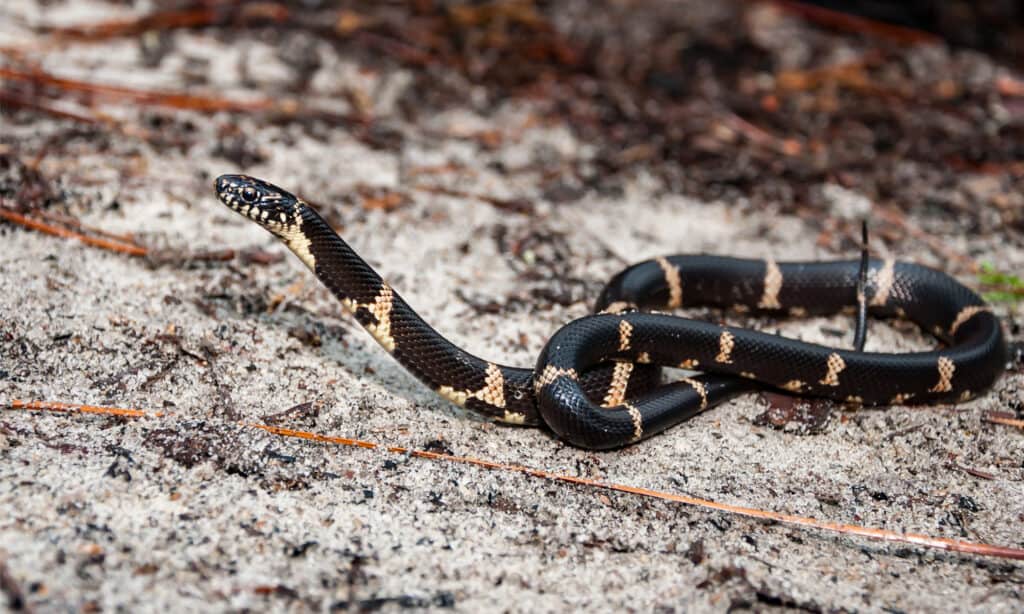
The eastern kingsnake is probably the most commonly seen kingsnake in Florida.
©iStock.com/JasonOndreicka
Kingsnakes are a group of snakes that include examples like the Apalachicola kingsnake, eastern kingsnake, and the Florida kingsnake. Kingsnakes vary in color, size, and patterns quite drastically. The most common of them all is probably the eastern kingsnake. Eastern kingsnakes are large snakes with black bodies and a white banding pattern.
Scarlet kingsnakes can be found throughout the entirety of Florida, including the Keys.
Eastern kingsnakes can be found “north of a line from Pinellas County to Flagler County and west into the Panhandle, excluding the eastern Apalachicola lowlands south of Telogia Creek.”
The Florida kingsnake can be found south of Taylor County and into the Keys.
The northern mole kingsnake can be found in the Panhandle and as far east as Franklin County.
The Apalachicola king snake can be found in the Panhandle around the Apalachicola lowlands of Telogia Creek.
The short-tailed kingsnake can be found in north central Florida and is exclusive to the region.
The South Florida mole kingsnake exclusively lives on the peninsula from Brevard County south to Lake Okeechobee and west to Charlotte and DeSoto counties.
Rat snakes
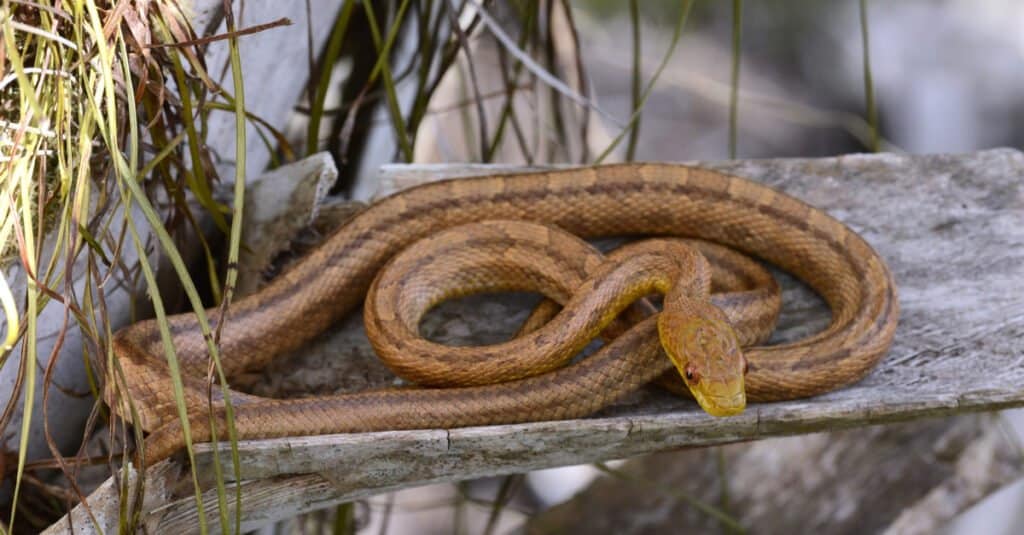
The eastern rat snake has light stripes on a yellow-colored body.
©Patrick K. Campbell/Shutterstock.com
The eastern rat snake, also known as the yellow rat snake, is a subspecies of rat snake native to Florida. Eastern rat snakes are long-bodied and have a yellowish-orange coloration with four lines running vertically from head to tail. Another subspecies, the gray rat snake, also lives in the region. Gray rat snakes are similarly sized but have a slate gray body with square brown markings down their backs.
Eastern rat snakes can be found in the Panhandle and through the peninsula as far south as Key Largo. Gray rat snakes can be found throughout the peninsula.
Ring-necked snake
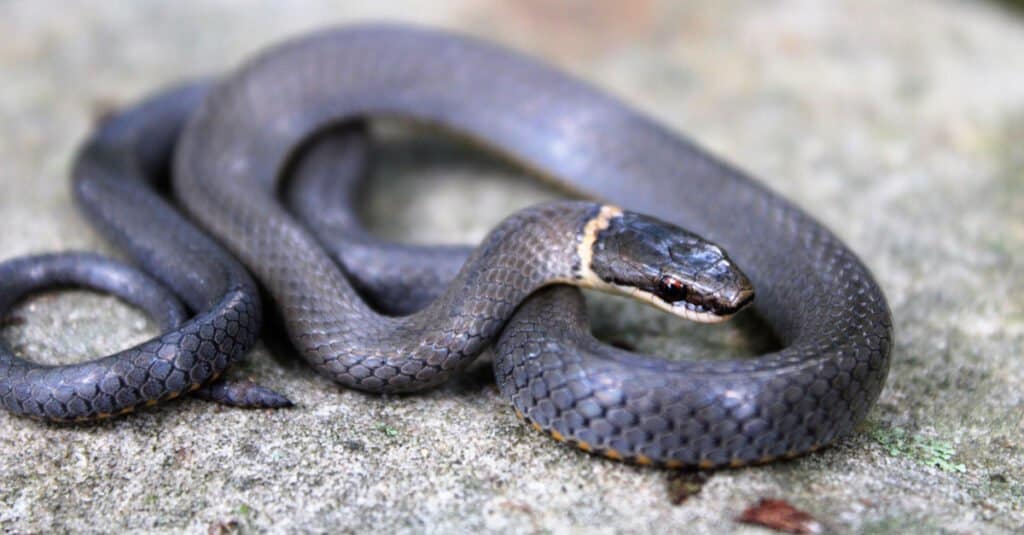
Ring-necked snakes are extremely common, though they aren’t seen that often.
©Tucker Heptinstall/Shutterstock.com
The ring-necked snake is extremely common if rarely seen. Ring-necked snakes are small snakes that rarely grow more than a foot long and have black bodies with distinctive orange or yellow bellies. They get their names from the ring of color around their necks.
Ring-necked snakes can be found everywhere in Florida, including the Keys. They are frequently burrowed or hiding under large flat objects like sheet metal or wood.
A complete list of nonvenomous snakes in Florida:
- North American racer
- Red corn snake
- Eastern rat snake
- Brahminy blind snake
- Ring-necked snake
- Eastern coachwhip
- Southern water snake
- Pine woods littersnake
- Common garter snake
- Rough green snake
- Scarletsnake
- Scarlet kingsnake
- Gray rat snake
- Red-bellied mud snake
- DeKay’s brown snake
- Brown water snake
- Florida brown snake
- Eastern indigo snake
- Eastern ribbon snake
- Eastern hog-nosed snake
- Rainbow snake
- Red-bellied snake
- Eastern kingsnake
- Salt marsh snake
- Black swamp snake
- Burmese python
- Florida kingsnake
- African rock python
- Eastern pine snake
- Florida crowned snake
- Smooth earth snake
- Midland water snake
- Striped swamp snake
- Northern mole kingsnake
- Mississippi green water snake
- Glossy swamp snake
- Rough earth snake
- Apalachicola kingsnake
- Boa constrictor
- Plain-bellied water snake
- Southeastern crowned snake
- Short-tailed kingsnake
- Southern hog-nosed snake
- South Florida mole kingsnake
- Queensnake
- Rim Rock crowned snake
- Javan file snake
The photo featured at the top of this post is © Valt Ahyppo/Shutterstock.com
Discover the "Monster" Snake 5X Bigger than an Anaconda
Every day A-Z Animals sends out some of the most incredible facts in the world from our free newsletter. Want to discover the 10 most beautiful snakes in the world, a "snake island" where you're never more than 3 feet from danger, or a "monster" snake 5X larger than an anaconda? Then sign up right now and you'll start receiving our daily newsletter absolutely free.
Thank you for reading! Have some feedback for us? Contact the AZ Animals editorial team.







